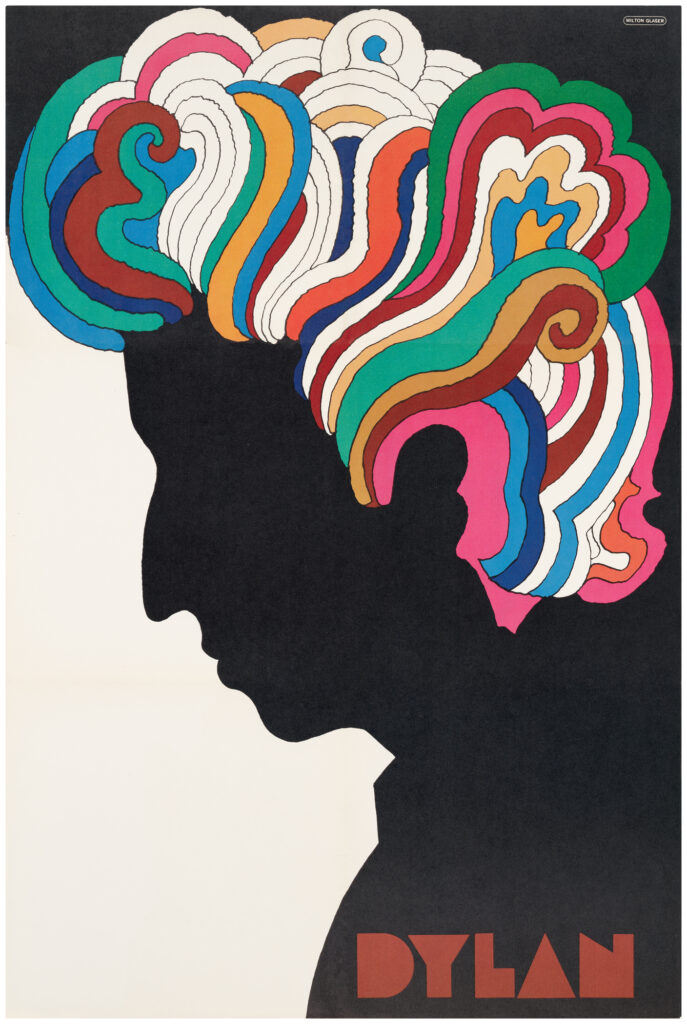
Can you picture the popular album covers from your youth? Maybe you still treasure the tattered T-shirt from your first concert or even that mixtape from your high school crush? There’s no denying that music provides a soundtrack to our lives, but design, in its many forms, supercharges the experience. Art of Noise, opening May 4 on Floor 7, amplifies the vital connection between music and design through culture-changing products and graphics that have revolutionized the listening experience and made their way into our collective memory.
“Art of Noise presents a century of visual artifacts of our musical experience, bringing forward decades of designs for presentation, performance, and playback through different eras and genres,” says Joseph Becker, curator of architecture and design and organizer of the exhibition. “It tracks the revolutions of our listening devices and environments, from radio broadcasts to A.I.-generated playlists, playbills to music videos, and boomboxes to wireless headphones.”
Among the over 800 works in the exhibition are more than 500 concert posters, 120 record album covers, 100 design objects, and four sound installations. They include Milton Glaser’s Bob Dylan poster for the singer’s 1967 greatest hits record and Factory Records’ poster for Joy Division’s 1979 album Unknown Pleasures, iconic images that exemplify how visual art fuels connections to performers and their music. In its coverage of design objects, Art of Noise maps the evolution of groundbreaking playback devices, from early phonographs and transistor radios to the Sony Walkman and Apple iPod, products that have advanced the medium through greater personalization and portability.
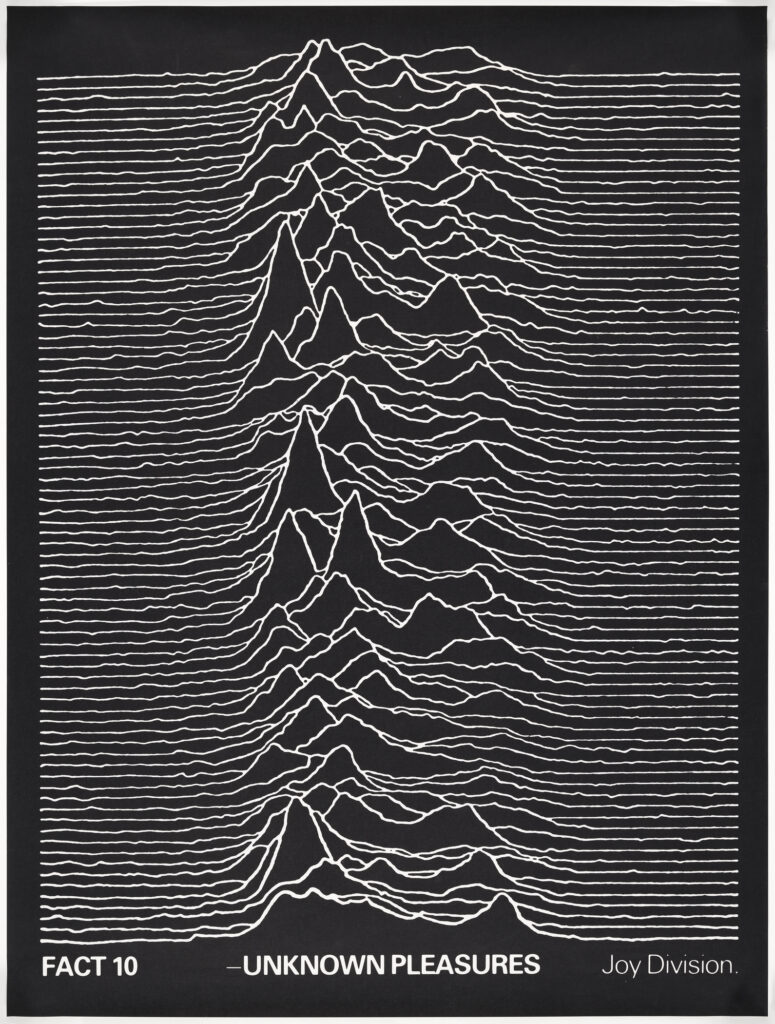
Special cuts include the unique exhibition environment created in partnership with the internationally renowned design and technology studio teenage engineering. Another is a window into Bay Area artists and innovators whose contributions have transformed popular culture, such as the psychedelic posters of graphic designers like Lee Conklin, Bonnie MacLean, Victor Moscoso, and David Singer in the 1960s and 1970s and Apple Inc.’s audio products beginning in the 2000s.
“San Francisco has strong graphic design and industrial design communities, both past and present,” says Becker. “Music is one of these focal points where both disciplines intersect and draw people in, giving visual form to our shared experience of sound.”
Read on for more exhibition highlights organized around four themes: design products, posters and album art, exhibition design and interactives, and sound experiences.
Design Products
Art of Noise recognizes designers who have had a trailblazing impact on audio product design. One innovator is Dieter Rams, whose phonographs, stereos, and other electronics for Braun from 1959 until 1997 have shaped the modern listening experience. Rams’s ten-point philosophy of “good design” includes an approach that is unobtrusive, minimalist, thorough to the last detail, and guided by aesthetics that integrate with how a product is used. Among his devices on view is SK-4 (1956), a combination radio-phonograph nicknamed “Snow White’s Coffin” for its plastic lid over a sleek box design; it was also part of a revolution in the aesthetics of audio products, bringing the crisp edges of modernism and new materials like bent acrylic to more compact technology.
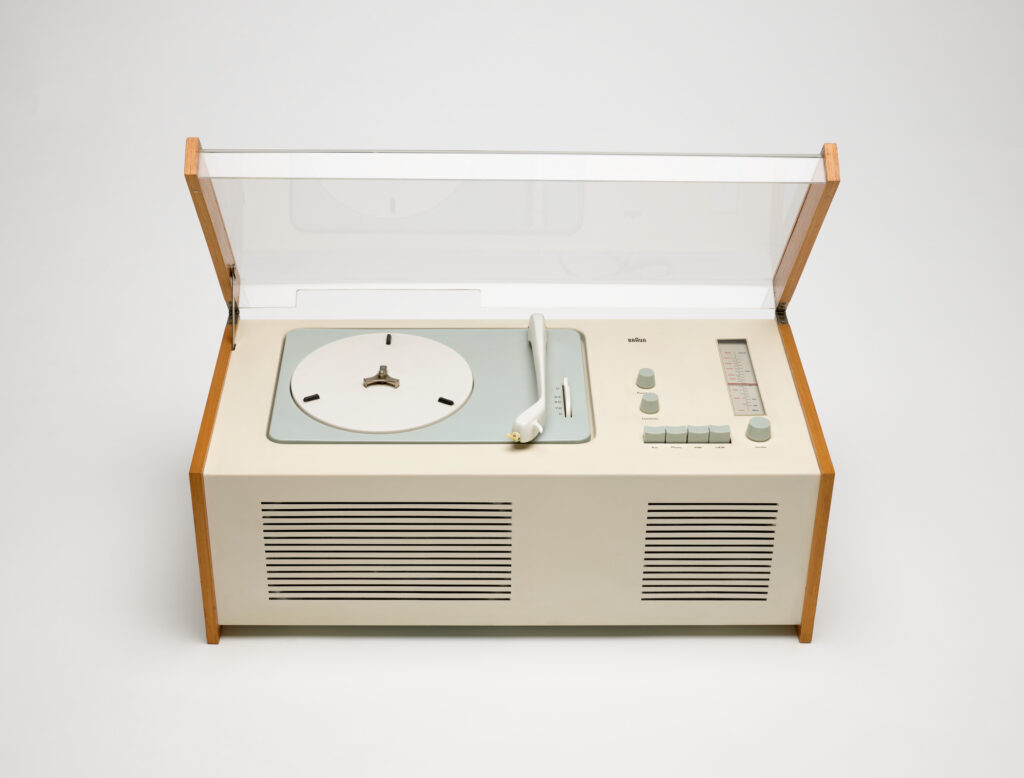
Portability—how aesthetics, engineering ingenuity, and groundbreaking design have merged in the last 50 years to transform the listening experience—is a throughline unifying many of the 100 featured items. “Objects like the Walkman or the iPod tell stories that even if you didn’t own one, you understand,” Becker says. “In seeing these works in this context, you may remember what the button or click wheel feel like, how interesting these devices were to interact with, the level of intention in how they were designed, and what they symbolized: the freedom of taking your music with you wherever you wanted to go.”
Going against the grain of sleek industrial design are works like Ron Arad’s Concrete Stereo (1983) and Tom Sachs’s Model Thirty-Six (2014), experimental stereos that challenge the established notions of form and function. The postindustrial and punk aesthetic of Arad’s piece subverts the stereo as an aspirational status symbol by deconstructing and embedding its components, still fully operational, into rough concrete. Model Thirty-Six, a boombox encased in a cinder block, elevates what Sachs described in a 2015 New York Times Style Magazine interview as “‘haute bricolage’—the glory of humble materials and the ingenious things you can build using them.”
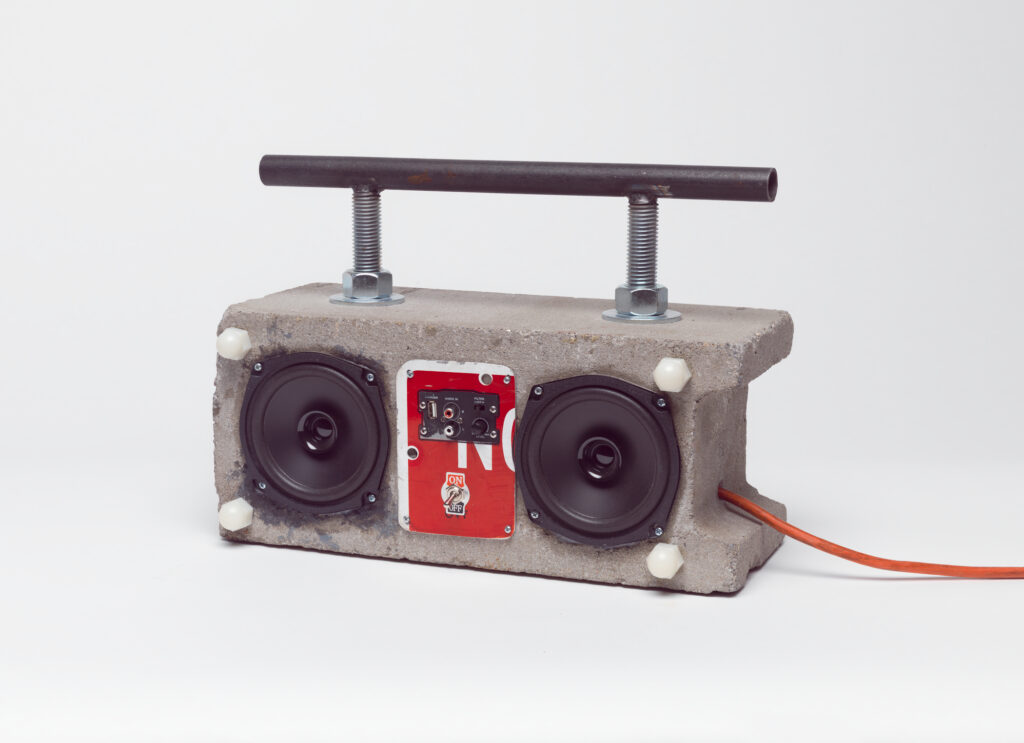
Taking audio electronics in an entirely different direction is Mathieu Lehanneur’s Power of Love (2009), a sculpture of golden flames with a built-in mp3 player that evokes the romantic draw of a crackling fire and queues up sounds for two. Conceived as a relationship aid for couples, Lehanneur “focused on the ideal moment of the first encounter, on the incredible synchronization of the encounter, as if the fireworks sparked by the encounter could be frozen in time and space and one could keep a trace, a souvenir, a kind of unspoiled fossil,” he has said.
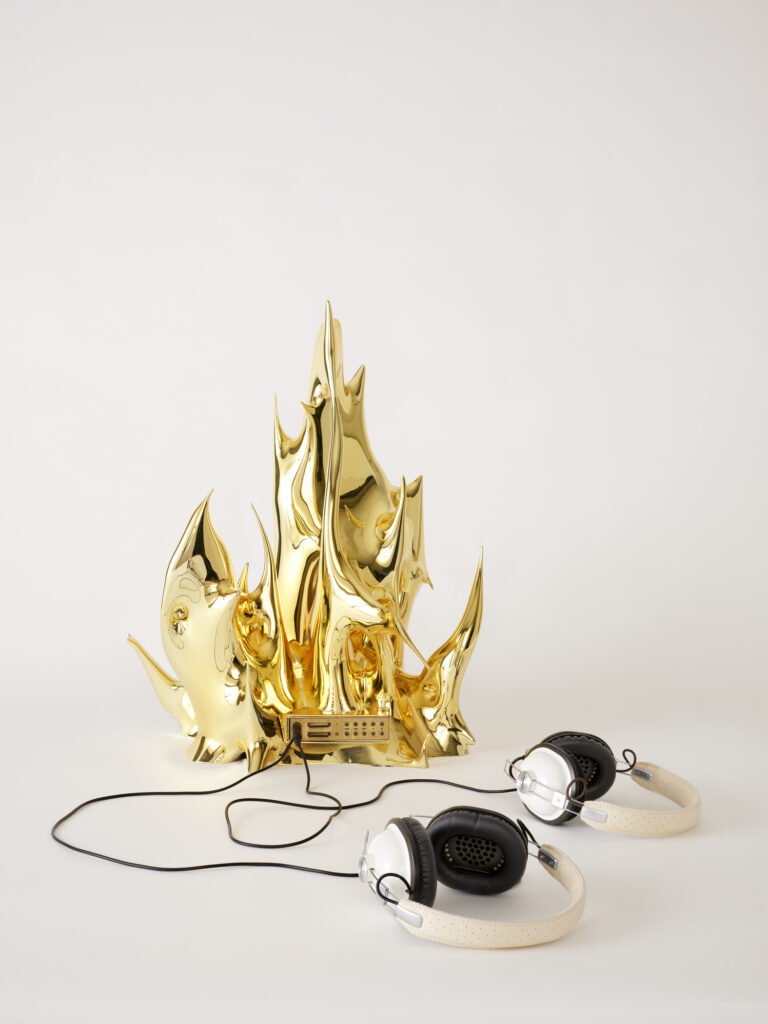
Posters and Album Art
Whether one experienced the 1960s and 1970s San Francisco music scene firsthand or through its enduring legacy in popular culture, the concert posters associated with landmark venues like Winterland, the Fillmore Auditorium, and Avalon Ballroom are indelible markers of the time. Art of Noise’s first gallery is a temple to music graphics and offers an incredible ceiling-to-floor display of nearly 500 psychedelic rock posters, the vast majority gifted to SFMOMA from local collector Jim Chanin, featuring bands such as Big Brother and the Holding Company, Quicksilver Messenger Service, and the Grateful Dead. The acid colors, eye-bending, often illegible lettering, and trippy vibrating images of these posters—many shown together for the first time—reflect the ascendance of the counterculture as a societal and artistic force and chart a pioneering moment in the history of music, San Francisco, and graphic design.
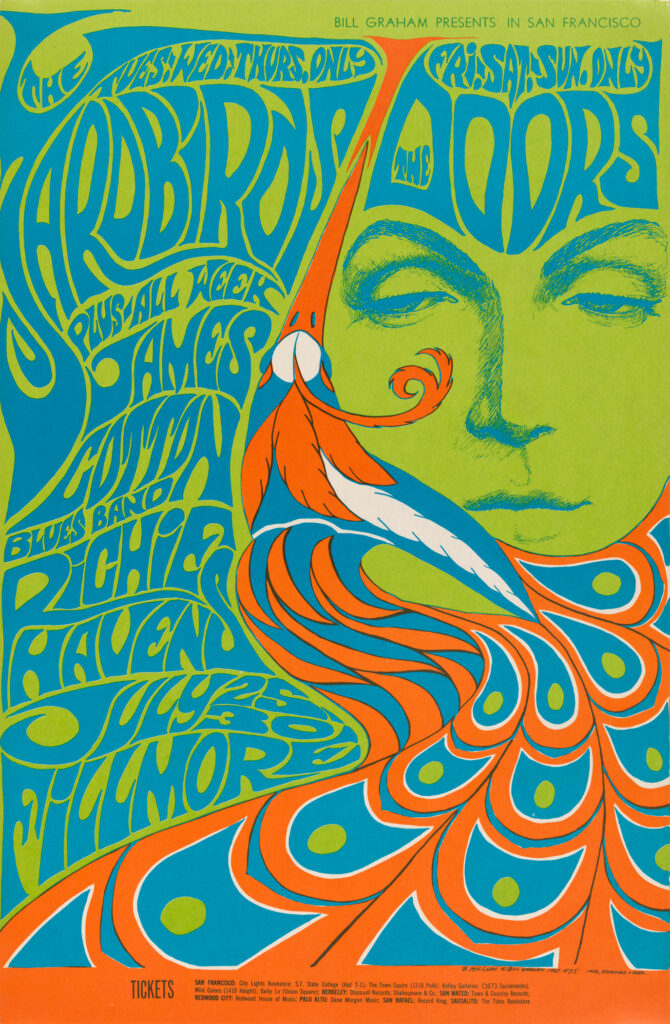
Expanding the scope, Becker has also gathered more recent prints and ephemera, including rap concert posters for Tupac, Notorious B.I.G., and LL Cool J; works for alternative and indie rock bands by Rex Ray, Jason Munn, and Urban Inks; and Takenobu Igarashi’s graphics for Tokyo Summer Jazz. Low-tech, high-tension punk rock concert fliers from the 1980s and often fantastical, color-saturated, and digitally designed rave fliers from the 1990s further spotlight the Bay Area’s local scene.
A trove of album covers from SFMOMA’s Library Special Collection and San Francisco’s Letterform Archive track an evolution in modernist graphic design and includes the work of artists like designer and activist Laini (Sylvia) Abernathy, a member of Chicago’s Black Arts Movement and believed to be the first Black woman credited as designer for an album cover. Abernathy worked with the blues and jazz label Delmark Records, designing covers for artists including the Roscoe Mitchell Sextet and Sun Ra. For Mitchell’s cover she used bold black concentric circles around a black and white image taken by her husband, photographer Billy Abernathy. The approach emphasizes “the dignity, beauty, and blackness of the subject,” a goal identified by the Organization of Black American Culture, a key group in the Black Arts Movement.
Exhibition Design + Interactives
To create the exhibition experience, Becker collaborated with the pioneering design and technology studio teenage engineering, a Swedish firm whose minimalist digital and analog audio electronics, from synthesizers and Bluetooth speakers to headphones and recording devices, have garnered an avid fanbase. Their audio objects on display range from a bespoke deejay deck (2019) created for the late fashion designer Virgil Abloh, to the more affordable and accessible IKEA Frekvens (2020), a modular sound system with attachable LED lights that allow you to bring your music and a party wherever you go.
Art of Noise is the studio’s first design of an exhibition environment, and it is a fitting foray that merges its expertise in visual and industrial design, engineering, and user interface. The blue walls, display tables, and in-gallery seating create a future-forward, contemplative environment, further activated through an interactive seating landscape designed by teenage engineering where visitors can use headphones and playback devices to listen to curated playlists and watch music advertising and videos on a custom-built mini-TV device.
“Objects like the Walkman and iPod tell stories that even if you didn’t own one, you understand.”
The studio will also present Choir (2022), a charming, meditative sound experience that reimagines the idea of choral chamber music for the synthesizer era. Featuring audio speakers in the form of eight wooden dolls, each less than one foot tall and with a distinct look and vocal range, the installation “sings” classic compositions from baroque to barbershop as an octet, complete with solos and a cappella harmonies. (Read more about teenage engineering in a recent interview available on the exhibition web page.)
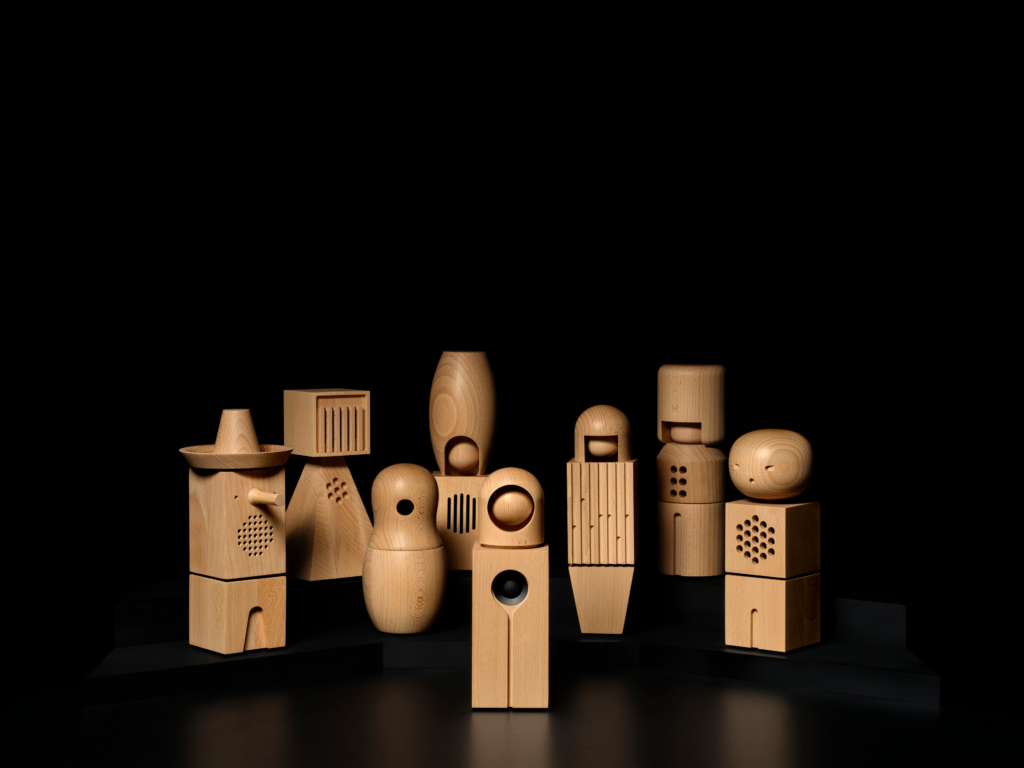
Sound Experiences
Art of Noise explores the communal side of music through two additional sound experiences. Three tree-like sculptures of yellow, orange, and green metal tubes form the basis for designer, sound artist, and electronic musician Yuri Suzuki’s whimsical Arborhythm (2024), on the Floor 2 landing off the Howard Street entrance. Each tube culminates in a horn-shaped speaker that plays a constantly evolving soundtrack of ambient and calming sounds remixed from recordings of our local urban and natural environment, including foghorns and ocean waves recorded around the city, playfully connecting visitors to our surroundings.
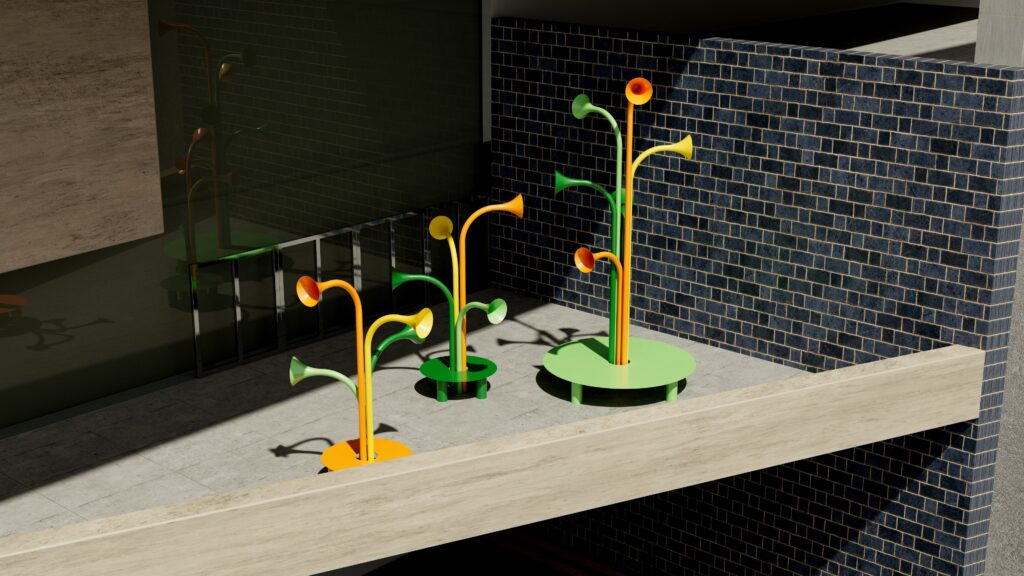
Devon Turnbull, whose audio design work is produced under the moniker Ojas, is a multidisciplinary artist who works in music, fashion, and graphic design. Known for his Brutalist high-performance hand-built sound systems, the speaker sculptor and icon of audiophiles is creating Hifi Pursuit Listening Room Dream No. 2 (2024), a site-specific immersive listening environment designed for SFMOMA. This listening room—one of a handful of his “shrines to music”—will be activated throughout the run of the exhibition by live operators, from record and reel-to-reel collectors to musicians and archivists.
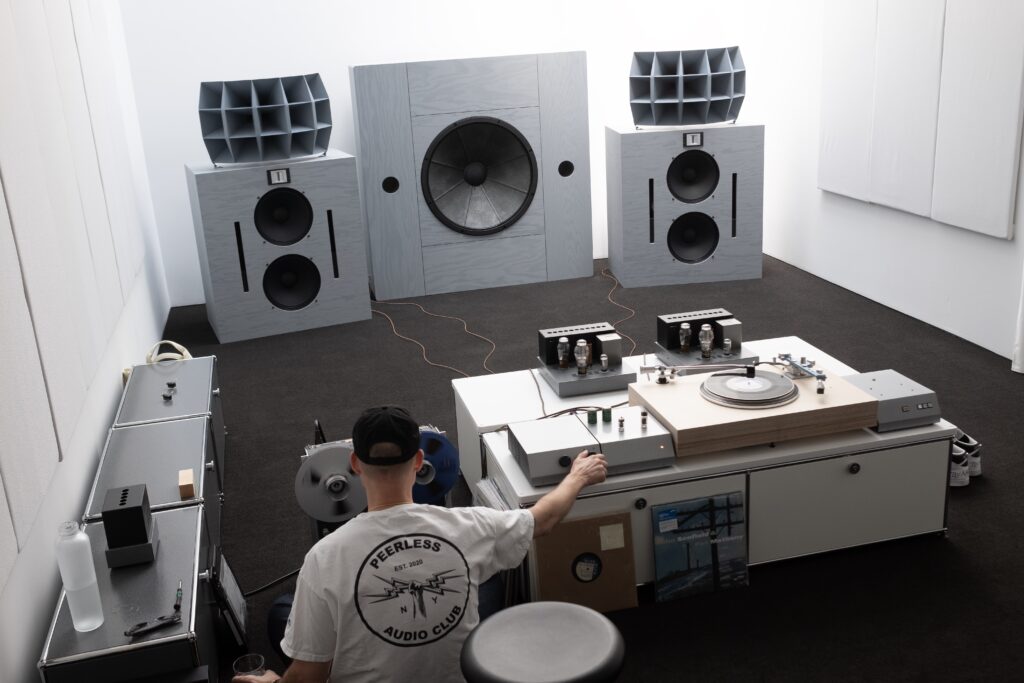
By elevating common consumer products and experiences, Art of Noise offers visitors a new perspective into museums. “When people come into the museum and see something that is familiar, but presented in this rarefied environment, it encourages them to think differently about what they see in the museum and the objects and designs that they interact with in their daily life,” Becker states.
Explore this mix of vintage, cutting-edge, and memory-making works that will have some looking back nostalgically on the experiences of their youth, others looking excitedly toward the next wave of sound technology, and all reveling in the joy of music.
Art of Noise is on view May 4 through August 18, 2024, on Floor 7.
Major support for Art of Noise is provided by Mary Jo and Dick Kovacevich, The Bernard Osher Foundation, and the Bernard and Barbro Osher Exhibition Fund.
Significant support is provided by Deborah and Kenneth Novack.
Meaningful support is provided by Sonya Yu.
Additional support is provided by Aston and Aushlee Motes and the Diane and Howard Zack Fund for Architecture and Design.